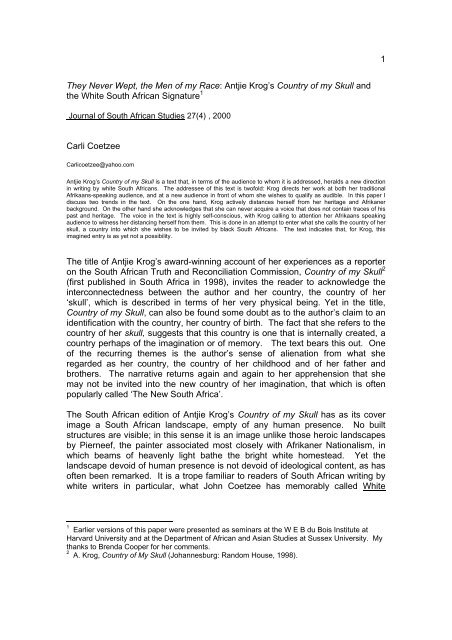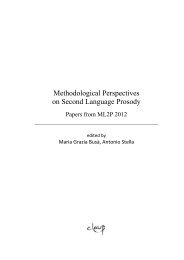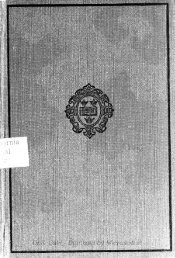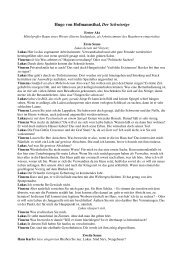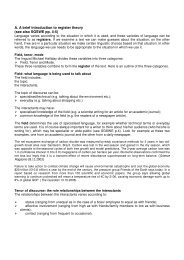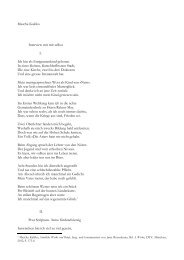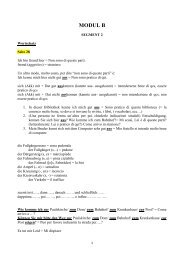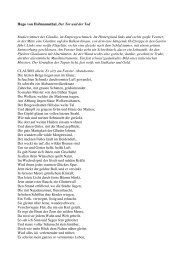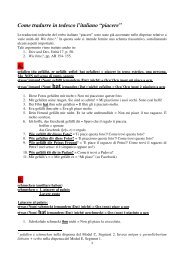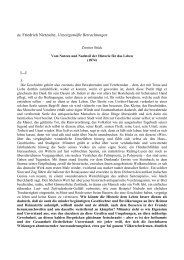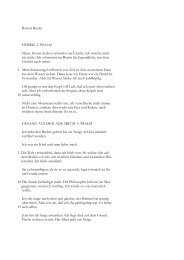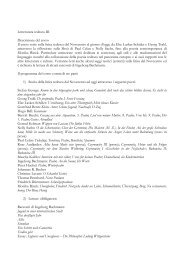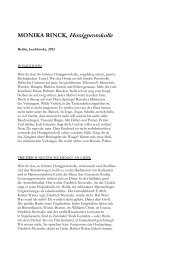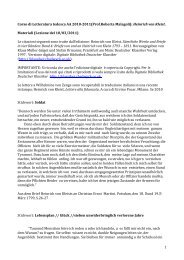1 They Never Wept, the Men of my Race: Antjie Krog's Country of my ...
1 They Never Wept, the Men of my Race: Antjie Krog's Country of my ...
1 They Never Wept, the Men of my Race: Antjie Krog's Country of my ...
Create successful ePaper yourself
Turn your PDF publications into a flip-book with our unique Google optimized e-Paper software.
1<br />
<strong>They</strong> <strong>Never</strong> <strong>Wept</strong>, <strong>the</strong> <strong>Men</strong> <strong>of</strong> <strong>my</strong> <strong>Race</strong>: <strong>Antjie</strong> Krog’s <strong>Country</strong> <strong>of</strong> <strong>my</strong> Skull and<br />
<strong>the</strong> White South African Signature 1<br />
Journal <strong>of</strong> South African Studies 27(4) , 2000<br />
Carli Coetzee<br />
Carlicoetzee@yahoo.com<br />
<strong>Antjie</strong> Krog’s <strong>Country</strong> <strong>of</strong> <strong>my</strong> Skull is a text that, in terms <strong>of</strong> <strong>the</strong> audience to whom it is addressed, heralds a new direction<br />
in writing by white South Africans. The addressee <strong>of</strong> this text is tw<strong>of</strong>old: Krog directs her work at both her traditional<br />
Afrikaans-speaking audience, and at a new audience in front <strong>of</strong> whom she wishes to qualify as audible. In this paper I<br />
discuss two trends in <strong>the</strong> text. On <strong>the</strong> one hand, Krog actively distances herself from her heritage and Afrikaner<br />
background. On <strong>the</strong> o<strong>the</strong>r hand she acknowledges that she can never acquire a voice that does not contain traces <strong>of</strong> his<br />
past and heritage. The voice in <strong>the</strong> text is highly self-conscious, with Krog calling to attention her Afrikaans speaking<br />
audience to witness her distancing herself from <strong>the</strong>m. This is done in an attempt to enter what she calls <strong>the</strong> country <strong>of</strong> her<br />
skull, a country into which she wishes to be invited by black South Africans. The text indicates that, for Krog, this<br />
imagined entry is as yet not a possibility.<br />
The title <strong>of</strong> <strong>Antjie</strong> Krog’s award-winning account <strong>of</strong> her experiences as a reporter<br />
on <strong>the</strong> South African Truth and Reconciliation Commission, <strong>Country</strong> <strong>of</strong> <strong>my</strong> Skull 2<br />
(first published in South Africa in 1998), invites <strong>the</strong> reader to acknowledge <strong>the</strong><br />
interconnectedness between <strong>the</strong> author and her country, <strong>the</strong> country <strong>of</strong> her<br />
‘skull’, which is described in terms <strong>of</strong> her very physical being. Yet in <strong>the</strong> title,<br />
<strong>Country</strong> <strong>of</strong> <strong>my</strong> Skull, can also be found some doubt as to <strong>the</strong> author’s claim to an<br />
identification with <strong>the</strong> country, her country <strong>of</strong> birth. The fact that she refers to <strong>the</strong><br />
country <strong>of</strong> her skull, suggests that this country is one that is internally created, a<br />
country perhaps <strong>of</strong> <strong>the</strong> imagination or <strong>of</strong> memory. The text bears this out. One<br />
<strong>of</strong> <strong>the</strong> recurring <strong>the</strong>mes is <strong>the</strong> author’s sense <strong>of</strong> alienation from what she<br />
regarded as her country, <strong>the</strong> country <strong>of</strong> her childhood and <strong>of</strong> her fa<strong>the</strong>r and<br />
bro<strong>the</strong>rs. The narrative returns again and again to her apprehension that she<br />
may not be invited into <strong>the</strong> new country <strong>of</strong> her imagination, that which is <strong>of</strong>ten<br />
popularly called ‘The New South Africa’.<br />
The South African edition <strong>of</strong> <strong>Antjie</strong> Krog’s <strong>Country</strong> <strong>of</strong> <strong>my</strong> Skull has as its cover<br />
image a South African landscape, empty <strong>of</strong> any human presence. No built<br />
structures are visible; in this sense it is an image unlike those heroic landscapes<br />
by Pierneef, <strong>the</strong> painter associated most closely with Afrikaner Nationalism, in<br />
which beams <strong>of</strong> heavenly light ba<strong>the</strong> <strong>the</strong> bright white homestead. Yet <strong>the</strong><br />
landscape devoid <strong>of</strong> human presence is not devoid <strong>of</strong> ideological content, as has<br />
<strong>of</strong>ten been remarked. It is a trope familiar to readers <strong>of</strong> South African writing by<br />
white writers in particular, what John Coetzee has memorably called White<br />
1 Earlier versions <strong>of</strong> this paper were presented as seminars at <strong>the</strong> W E B du Bois Institute at<br />
Harvard University and at <strong>the</strong> Department <strong>of</strong> African and Asian Studies at Sussex University. My<br />
thanks to Brenda Cooper for her comments.<br />
2 A. Krog, <strong>Country</strong> <strong>of</strong> My Skull (Johannesburg: Random House, 1998).
2<br />
Writing: <strong>the</strong> writing which reflects <strong>the</strong> concerns <strong>of</strong> a people no longer European,<br />
not yet African. 3<br />
In this sense <strong>the</strong> landscape on <strong>the</strong> cover <strong>of</strong> Krog’s book, a photograph by George<br />
Hallet, can be interpreted using <strong>the</strong> vocabulary familiar to readers <strong>of</strong> white<br />
writing, that literature <strong>of</strong> disembodied landscapes. It is a literature that fails, in<br />
Coetzee’s words, to imagine a relationship with South Africa’s indigenous<br />
inhabitants: ‘Official historiography long told a tale <strong>of</strong> how until <strong>the</strong> nineteenth<br />
century <strong>of</strong> <strong>the</strong> Christian era <strong>the</strong> interior <strong>of</strong> what we now call South Africa was<br />
unpeopled. The poetry <strong>of</strong> empty space may one day be accused <strong>of</strong> fur<strong>the</strong>ring<br />
<strong>the</strong> same fiction’. 4 But in <strong>Antjie</strong> Krog’s work, I want to argue, this landscape<br />
comes to represent something new and different in white writing, and perhaps -<br />
more ambitiously – marks a change in white writing in <strong>the</strong> sense that Coetzee<br />
defines it.<br />
Krog’s country <strong>of</strong> her skull is a landscape from which she feels herself barred, as<br />
a white South African, on account <strong>of</strong> her whiteness, on account <strong>of</strong> <strong>the</strong> name <strong>of</strong><br />
her fa<strong>the</strong>r. It is a landscape familiar from her childhood, <strong>the</strong> landscape <strong>of</strong> <strong>the</strong><br />
fa<strong>the</strong>rs and <strong>the</strong> bro<strong>the</strong>rs; but she can never again enter it. And at <strong>the</strong> same time<br />
it is a landscape into which she wishes to be invited by her fellow South Africans.<br />
But <strong>the</strong> figure in <strong>the</strong> landscape is distinctly different from Coetzee’s lone figure<br />
unable to imagine ano<strong>the</strong>r presence. In Krog’s work, I argue in this paper, <strong>the</strong>re<br />
is a self-conscious desire to address an audience that includes black South<br />
Africans. As I will show in this paper, <strong>the</strong> addressee <strong>of</strong> <strong>the</strong> text is not stable. At<br />
times it seems clear that <strong>the</strong> text invokes as readers fellow-Afrikaners, those<br />
whom Krog wishes to convince <strong>of</strong> our/<strong>the</strong>ir guilt and complicity in South Africa’s<br />
injustices, as recorded by <strong>the</strong> proceedings <strong>of</strong> <strong>the</strong> Truth and Reconciliation<br />
Commission. At o<strong>the</strong>r times, <strong>the</strong> text is explicitly addressed to those whom Krog<br />
invests with <strong>the</strong> power to allow her into <strong>the</strong> country <strong>of</strong> her imagination and heart. 5<br />
The back flap <strong>of</strong> <strong>the</strong> Krog text shows a photograph <strong>of</strong> <strong>the</strong> author, superimposed<br />
on <strong>the</strong> landscape, standing at a window, perhaps looking out, her hand touching<br />
its own reflected image. The book, as is well known, is based on <strong>the</strong> reports<br />
done for <strong>the</strong> South African Broadcasting Service, where Krog worked under <strong>the</strong><br />
name <strong>Antjie</strong> Samuel – her married name. The copyright <strong>of</strong> <strong>the</strong> book is in <strong>the</strong><br />
name <strong>of</strong> <strong>Antjie</strong> Samuel, <strong>the</strong> biographical note on <strong>the</strong> back describes <strong>Antjie</strong> Krog,<br />
who it says reported ‘as <strong>Antjie</strong> Samuel’. This divided identity, this double<br />
signature, is more than a case <strong>of</strong> a married woman making a choice to publish<br />
3 J. M. Coetzee, White Writing: On <strong>the</strong> Culture <strong>of</strong> Letters in South Africa (Johannesburg, Radix,<br />
1988), p. 11.<br />
4 Ibid., p. 177.<br />
5 What remains outside <strong>the</strong> scope <strong>of</strong> this paper is <strong>the</strong> reception <strong>of</strong> Krog’s text by her readers.<br />
This paper forms part <strong>of</strong> a larger book-length project, provisionally (and ironically) called Going<br />
Native, in which I explore some <strong>of</strong> <strong>the</strong> ways in which white South African writing has imagined a<br />
black interlocutor. In this work, too, <strong>the</strong> focus is not on <strong>the</strong> actual reception <strong>of</strong> <strong>the</strong> work by black<br />
readers, but ra<strong>the</strong>r on <strong>the</strong> effects <strong>of</strong> imagining an addressee beyond what J M Coetzee might call<br />
‘white reading.’
3<br />
under her maiden name (which is <strong>of</strong> course always still her fa<strong>the</strong>r’s name). The<br />
nature <strong>of</strong> <strong>the</strong> signature in this text points to a series <strong>of</strong> displacements and<br />
sometimes uncomfortable divisions: Krog uses <strong>the</strong> work written by <strong>Antjie</strong> Samuel,<br />
publishing it here under her own name, her o<strong>the</strong>r name, but in English, which is<br />
not <strong>the</strong> language associated with <strong>the</strong> signature ‘Krog’.<br />
The signature <strong>of</strong> <strong>the</strong> text is significant, in terms <strong>of</strong> <strong>the</strong> audience it invokes: <strong>Antjie</strong><br />
Krog is <strong>the</strong> name under which <strong>the</strong> author is known as <strong>the</strong> adored woman poet <strong>of</strong><br />
<strong>the</strong> Afrikaans tradition. Choosing to publish this work under ‘Krog’, her signature<br />
name as an Afrikaans poet, she manages to invoke <strong>the</strong> world <strong>of</strong> her youth, so<br />
<strong>of</strong>ten described in her work. The signature thus captures <strong>the</strong> attention <strong>of</strong> her<br />
Afrikaans-speaking readers, who are called on to take notice, and are forced to<br />
read this book alongside, on top <strong>of</strong>, <strong>the</strong> o<strong>the</strong>r work produced under this signature.<br />
Krog published her first collections <strong>of</strong> poetry while still at school. 6 In <strong>the</strong>se early<br />
works, described in one famous line as “barefoot” poetry, 7 she evokes a rural<br />
childhood in <strong>the</strong> heart <strong>of</strong> <strong>the</strong> country. Her later work shows an incresing concern<br />
with <strong>the</strong> wider political realities <strong>of</strong> South Africa. The work on <strong>the</strong> Truth and<br />
Reconciliation Commission is anticipated to some extent in her 1989 Collection<br />
<strong>of</strong> poetry, Lady Anne, and in <strong>the</strong> novella Relaas van ‘n moord (1995). 8 In both <strong>of</strong><br />
<strong>the</strong>se texts, <strong>the</strong> narrator resembles <strong>the</strong> autobiographical Krog closely. Both<br />
conern a woman, A. (<strong>Antjie</strong>), who lives in a small South African Town, K.<br />
(Kroonstad) with her husband and three children, and is involved in local politics.<br />
The world evoked is that <strong>of</strong> a white, Afrikaans-speaking, middle-class family, but<br />
Krog places this family against a backdrop <strong>of</strong> injustice and <strong>the</strong> political unrest <strong>of</strong><br />
<strong>the</strong> 1980s in South Africa 9 .<br />
Peggy Kamuf in her Signature Pieces: On <strong>the</strong> Institution <strong>of</strong> Authorship writes <strong>of</strong><br />
what she calls <strong>the</strong> ‘double-jointedness <strong>of</strong> signatures’, as ‘an always divisible limit<br />
within <strong>the</strong> difference between writer and work, “life” and “letters”’. She continues<br />
that <strong>the</strong> signature is what allows us ‘to perform, in a more or less reliable manner,<br />
operations <strong>of</strong> identification, attestation, verification, attribution <strong>of</strong> responsibility,<br />
and so forth’. 10 A signature, she writes, ‘is not an author or even simply <strong>the</strong><br />
proper name <strong>of</strong> an author. It is <strong>the</strong> mark <strong>of</strong> an articulation at <strong>the</strong> border between<br />
life and letters, body and language’. 11 In this sense, I want to suggest, <strong>the</strong> choice<br />
<strong>of</strong> <strong>the</strong> signature ‘Krog’ is not a cynical sales ploy, as has been suggested by<br />
6 A. Krog, Dogter van Jefta (Cape Town, Human & Rousseau, 1970) and Januarie-suite (Cape<br />
Town, Human & Rousseau, 1972).<br />
7 In <strong>the</strong> poem “Ma”, Krog writes: “Ma, ek skryf vir jou ‘n gedig/sonder fênsie leestekens/ sonder<br />
woorde wat rym/ sonder bywoorde/ net sommer/ ‘n kaalvoet gedig” (Ma, I write a poem for you,<br />
without fancy punctuation, without words that rhyme, without adverbs, simply a barefoot poem).<br />
8 A. Krog, Lady Anne (Johannesburg, T aurus, 1989) and A. Krog, Relaas van ‘n Moord (Cape<br />
Town, Human & Rousseau, 1995).<br />
9 For one <strong>of</strong> <strong>the</strong> very few discussions written in English <strong>of</strong> Krog’s work before <strong>Country</strong> <strong>of</strong> <strong>my</strong><br />
Skull, see P. P. van der Merwe, “A Poet’s Commitment: <strong>Antjie</strong> Krog’s Lady Anne (Current<br />
Writing: Tetx and Reception in Sou<strong>the</strong>rn Africa, October 1990), pp.131-146.<br />
10 P. Kamuf, Signature Pieces: On <strong>the</strong> Institution <strong>of</strong> Authorship (Ithaca and London, Cornell<br />
University Press, 1988), p. viii.<br />
11 ibid., p. 39.
4<br />
some reviewers; instead it is <strong>the</strong> author’s attempt to make explicit <strong>the</strong><br />
connections between her life and her letters, between <strong>the</strong> name <strong>of</strong> her ancestors<br />
and her work as a reporter on <strong>the</strong> Truth and Reconciliation Commission.<br />
In <strong>Country</strong> <strong>of</strong> <strong>my</strong> Skull Krog makes more than a few references to <strong>the</strong> fact that it<br />
is explicitly not poetry she is writing. So she is using <strong>the</strong> poet’s signature (<strong>Antjie</strong><br />
Krog ra<strong>the</strong>r than Samuel), only to erase it, to resist it. The book ends with a<br />
poem written by Krog, but significantly in English. The argument will return to<br />
this poem, but here it is useful to quote <strong>the</strong> last few lines to make <strong>my</strong> point about<br />
whom <strong>the</strong> book addresses:<br />
You whom I have wronged, please<br />
Take me<br />
With you. 12<br />
The signature which seems, <strong>the</strong>n, in <strong>the</strong> first place to indicate that this text is<br />
written for fellow-Afrikaners, addressed to <strong>the</strong>m/us is misleading. A number <strong>of</strong><br />
things, including this concluding poem, contradict this expectation. In <strong>the</strong> first<br />
place, <strong>the</strong> text is written in English, and has not (yet) been translated into<br />
Afrikaans. Unlike Krog’s o<strong>the</strong>r works, it was not published by her Afrikaner<br />
establishment publishers Human & Rousseau, but – in South Africa as well as in<br />
<strong>the</strong> United States - by Random House (a resonantly named publisher in <strong>the</strong><br />
context <strong>of</strong> this text which is so concerned with cultural homelessness). The book<br />
is dedicated in <strong>the</strong> following way ‘for every victim who had an Afrikaner surname<br />
on her lips’. This need not imply that <strong>the</strong>se victims are <strong>the</strong> only, or even primary,<br />
readers; but in this dedication Krog sets up an identification between <strong>the</strong><br />
signature (on <strong>the</strong> cover) and <strong>the</strong> Afrikaans name uttered by <strong>the</strong> ‘victim’. The<br />
extended title <strong>of</strong> <strong>the</strong> US edition, recently published by Times Books, a division <strong>of</strong><br />
Random House, <strong>Country</strong> <strong>of</strong> My Skull: Guilt, Sorrow, and <strong>the</strong> Limits <strong>of</strong><br />
Forgiveness in <strong>the</strong> New South Africa, 13 gives a more pessimistic gloss to <strong>the</strong><br />
original title, and also sets up an opposition between guilt and forgiveness, with<br />
sorrow as <strong>the</strong> term that possibly mediates between <strong>the</strong> two.<br />
On <strong>the</strong> cover <strong>of</strong> <strong>the</strong> US edition Krog’s name is smaller, <strong>the</strong> title bigger; and Krog<br />
is ‘introduced’ by Charlayne Hunter-Gault, award-winning US journalist and<br />
currently National Public Radio’s chief correspondent in Africa. Hunter-Gault’s<br />
introduction adds little that <strong>the</strong> South African introduction, called ‘Publisher’s<br />
Note’, 14 does not say; its value lies in <strong>the</strong> fact that Charlayne Hunter-Gault<br />
associates herself with <strong>the</strong> project, has a similar signature for US readers and<br />
viewers to Krog’s for South African readers and listeners.<br />
12 A. Krog, <strong>Country</strong> <strong>of</strong> My Skull (Johannesburg, Random House, 1998), p. 279.<br />
13 A. Krog, <strong>Country</strong> <strong>of</strong> My Skull: Guilt, Sorrow, and <strong>the</strong> Limits <strong>of</strong> Forgiveness in <strong>the</strong> New South<br />
Africa (New York, Random House, 1999).<br />
14 A. Krog, <strong>Country</strong> <strong>of</strong> My Skull (Johannesburg, Random House, 1998), pp. vi-viii.
5<br />
So when an addressee is invoked in <strong>the</strong> motto, a black woman, a ‘victim’, is<br />
addressed, and <strong>the</strong> text seems to be directed to a black audience. The author<br />
thus seems to be calling to attention her historic reading public, her Afrikaans<br />
readers, to witness her addressing a black woman; and in this address putting all<br />
<strong>the</strong> Afrikaans names (including that <strong>of</strong> her own family) on <strong>the</strong> lips <strong>of</strong> a woman<br />
who names <strong>the</strong>m as her aggressors and victimisers. 15 In this sense Krog’s text<br />
attempts to address, simultaneously, an audience that consists <strong>of</strong> black South<br />
Africans as victims <strong>of</strong> white aggression, and <strong>the</strong>ir white aggressors.<br />
This discussion <strong>of</strong> <strong>the</strong> images and <strong>the</strong> signature indicates that this text can be<br />
seen as divided against itself, doubling up on itself. In this sense its concern with<br />
address is symptomatic <strong>of</strong> a crisis around audience I find not only in this text, but,<br />
more generally, in o<strong>the</strong>r recent texts by white South Africans. It is a crisis about<br />
<strong>the</strong> name <strong>of</strong> <strong>the</strong> fa<strong>the</strong>rs, <strong>the</strong> legacy <strong>of</strong> <strong>the</strong> past and <strong>of</strong> <strong>the</strong> Afrikaans language;<br />
and a crisis around who <strong>the</strong> addressee <strong>of</strong> a text produced by a white South<br />
African could be. In texts like this one, <strong>the</strong> author is at pains to distinguish<br />
herself from <strong>the</strong> men <strong>of</strong> her race as she calls <strong>the</strong>m, and <strong>the</strong> voice becomes one<br />
in search <strong>of</strong> a new ear, a new genealogy into which she can write herself;<br />
because for her it has become impossible to speak any longer only in <strong>the</strong><br />
language <strong>of</strong> <strong>the</strong> fa<strong>the</strong>rs. Shoshana Felman, in ano<strong>the</strong>r context, in her work on<br />
testimony, writes <strong>of</strong> translation:<br />
Translation thus itself becomes a metaphor for history, not only in that it<br />
demands <strong>the</strong> rigor <strong>of</strong> a history devoid <strong>of</strong> pathos, but in that it opens up <strong>the</strong><br />
question <strong>of</strong> how to continue when <strong>the</strong> past, precisely, is not allowed any<br />
continuance. Translation is <strong>the</strong> metaphor <strong>of</strong> a new relation to <strong>the</strong> past, a<br />
relation that cannot resemble, fur<strong>the</strong>rmore, any past relation to <strong>the</strong> past<br />
but that consists, essentially, in <strong>the</strong> historical performance <strong>of</strong> a radical<br />
discontinuity….’ 16<br />
Hence Krog’s signing <strong>of</strong> her fa<strong>the</strong>r’s name, which is also <strong>the</strong> name <strong>of</strong> <strong>the</strong> beloved<br />
Afrikaner poet, and <strong>the</strong>n writing a text in English and dedicating it to <strong>the</strong> victim<br />
who had an Afrikaans name on her lips, can be read as a powerful statement<br />
about discontinuity, about <strong>the</strong> inability to continue with things as <strong>the</strong>y were<br />
before.<br />
Near <strong>the</strong> end <strong>of</strong> her book Krog describes a return to her family home, at<br />
Christmas time.<br />
15 The UK edition cover raises additional questions around signature and audience. The cover<br />
shows, instead <strong>of</strong> <strong>the</strong> landscape <strong>of</strong> <strong>the</strong> South African and US editions, a black woman holding<br />
what looks like a piece <strong>of</strong> earth. The woman on <strong>the</strong> photograph is Joyce Mthimkulu, and she is<br />
holding <strong>the</strong> last remains <strong>of</strong> her son. The portrait used on this cover seems to suggest,<br />
problematically, that Krog is speaking for someone like Joyce Mthimkulu. In <strong>the</strong> argument I make<br />
here I show how Krog goes to some trouble not to do this.<br />
16 S. Felman and D. Laub, Testimony: Crises in Witnessing in Literature, Psychoanalysis, and<br />
History (New York and London, Routledge, 1992), p. 162.
6<br />
From far I see <strong>the</strong> eucalyptus trees <strong>of</strong> <strong>my</strong> youth, <strong>the</strong>n <strong>the</strong> poplars and<br />
willows, and <strong>the</strong>n spangled by <strong>the</strong> midday light <strong>the</strong> sandstone house like a<br />
honeycomb…. On <strong>the</strong> gate is a huge notice: If you set foot on this farm<br />
without a specific appointment, expect to be met by an armed response. It<br />
appears in Afrikaans and Sesotho as well.<br />
Jerked out <strong>of</strong> our memories, we are all wide awake. Surely this has<br />
nothing to do with us? 17<br />
And <strong>of</strong> course it does not. In this case, <strong>the</strong> message’s double addressee, <strong>the</strong><br />
fact that it has been translated into Sesotho, indicates that <strong>the</strong> primary audience<br />
is <strong>the</strong> suspected cattle thieves against whom <strong>the</strong> bro<strong>the</strong>rs protect <strong>the</strong>ir families<br />
and herds. But this description <strong>of</strong> an arrival at <strong>the</strong> place that is supposed to be<br />
home, but which is barred, resonates for <strong>the</strong> book as a whole. ‘This is place that<br />
first wakened me for words and still does – after all <strong>the</strong>se years, <strong>the</strong>se many<br />
o<strong>the</strong>r voices’, 18 she writes. And <strong>the</strong>n: ‘I’ve written about this farm obsessively.<br />
No o<strong>the</strong>r season can heal <strong>my</strong> words. I don’t speak <strong>of</strong> it. I call not planets hi<strong>the</strong>r.<br />
My being is weak with it, hangs on to it – yet it can no longer come from me’. 19<br />
In a number <strong>of</strong> recent works by white South Africans a similar trope is used: <strong>the</strong><br />
return to <strong>the</strong> childhood farm, which serves as a way <strong>of</strong> focusing on <strong>the</strong> adult<br />
narrator’s sense <strong>of</strong> <strong>the</strong> loss <strong>of</strong> a way <strong>of</strong> being. 20 These are more than simply<br />
stories about loss <strong>of</strong> innocence; <strong>the</strong>y are narratives <strong>of</strong> a dramatic severance from<br />
<strong>the</strong> world and values <strong>of</strong> <strong>the</strong> Afrikaner ancestors, in which <strong>the</strong> narrator chooses<br />
not to continue <strong>the</strong> lineage and values <strong>of</strong> <strong>the</strong> fa<strong>the</strong>rs. Krog’s first chapter is titled<br />
‘<strong>They</strong> <strong>Never</strong> <strong>Wept</strong>, <strong>the</strong> <strong>Men</strong> <strong>of</strong> <strong>my</strong> <strong>Race</strong>’, and she begins her text thus:<br />
Sunk low on <strong>the</strong>ir springs, three wea<strong>the</strong>red white Sierras roar past <strong>the</strong><br />
wrought-iron gates <strong>of</strong> Parliament. Heavy, ham-like forearms bulge<br />
through <strong>the</strong> open windows – honking, waving old Free State and<br />
Transvaal flags. Hairy fists in <strong>the</strong> air. I run across <strong>the</strong> cobblestone street<br />
– clutching notepad and recorder – to <strong>the</strong> old parliamentary venue where<br />
<strong>the</strong> Justice Portfolio committee is hearing public submissions on what to<br />
include in <strong>the</strong> draft legislation establishing <strong>the</strong> Truth Commission.’ 21<br />
The narrator seems literally to be in flight from <strong>the</strong>se men, towards <strong>the</strong> Truth and<br />
Reconciliation Commission, clutching <strong>the</strong> tools that enable her to record what<br />
<strong>the</strong>se men, <strong>the</strong> unweeping men <strong>of</strong> her race, have done. The hairiness <strong>of</strong><br />
Afrikaner men comes up again and again, as <strong>the</strong> mark <strong>of</strong> a particular brand <strong>of</strong><br />
masculinity that makes tears (and possibly repentance) an impossibility. In<br />
17 A. Krog, <strong>Country</strong> <strong>of</strong> My Skull (Johannesburg, Random House, 1998), p. 272.<br />
18 Ibid.<br />
19 Ibid., p. 273.<br />
20 M. Rickards, ‘From Innocence to Absolution: Childhood Memory in Post-Apar<strong>the</strong>id White<br />
South African Texts’ (unpublished paper, Cape Town, 1998).<br />
21 Ibid., p. 1.
7<br />
Pretoria, Krog walks past a portrait <strong>of</strong> one <strong>of</strong> her ancestors: ‘Magistrate Krog –<br />
thick, hairy-necked’. 22 Coming across a group <strong>of</strong> Afrikaner men applying for<br />
amnesty from <strong>the</strong> Truth and Reconciliation Commission, she writes:<br />
It’s <strong>the</strong>m! It’s truly <strong>the</strong>m… I go cold with recognition…. The nightmare <strong>of</strong><br />
<strong>my</strong> youth…. I interview <strong>the</strong> one after <strong>the</strong> o<strong>the</strong>r in a quiet corner <strong>of</strong> <strong>the</strong><br />
Pretoria Synod hall. ‘You know, your whole body language and tone <strong>of</strong><br />
voice change when you are with <strong>the</strong>se men,’ says an English-speaking<br />
colleague. ‘I couldn’t hear what you were talking about, but <strong>the</strong>re is a<br />
definite intimacy…’ I say nothing, When I spoke to <strong>the</strong>m I did use all <strong>the</strong><br />
codes I grew up with, and have been fighting against for a lifetime. 23<br />
And between <strong>the</strong>se two scenes, <strong>of</strong> recognition and distance, comes <strong>the</strong> anecdote<br />
about Krog, <strong>the</strong> mo<strong>the</strong>r, sitting at <strong>the</strong> kitchen table with her youngest child who<br />
recites ‘<strong>the</strong> route <strong>of</strong> <strong>the</strong> blood through <strong>the</strong> body’. 24 She writes elsewhere,<br />
‘Afrikaners are usually versed in bloodlines’. 25 And it is this bloodline, which is<br />
also <strong>the</strong> line that could connect her to <strong>the</strong> farm <strong>of</strong> her childhood, that Krog severs<br />
by writing this book.<br />
It is through references to <strong>the</strong> Afrikaans language that this sense <strong>of</strong> severance<br />
and even betrayal is <strong>of</strong>ten clearest. The book, written as it is in English, does<br />
not use <strong>the</strong> language <strong>of</strong> her childhood, <strong>the</strong> language <strong>of</strong> <strong>the</strong> bro<strong>the</strong>rs and fa<strong>the</strong>rs –<br />
<strong>the</strong> men who do not weep. It would seem as if <strong>the</strong> codes <strong>of</strong> this ancestral<br />
language speak <strong>of</strong> ano<strong>the</strong>r landscape, now rejected by her – and one that rejects<br />
her in turn. She asks: ‘How do I live with <strong>the</strong> fact that all <strong>the</strong> words used to<br />
humiliate, all <strong>the</strong> orders given to kill, belonged to <strong>the</strong> language <strong>of</strong> <strong>my</strong> heart? At<br />
<strong>the</strong> hearings, many <strong>of</strong> <strong>the</strong> victims faithfully reproduced <strong>the</strong>se parts <strong>of</strong> <strong>the</strong>ir stories<br />
in Afrikaans as pro<strong>of</strong> <strong>of</strong> <strong>the</strong> bloody fingerprints on <strong>the</strong>m’. 26 This book, <strong>the</strong>n, is an<br />
attempt at a public distancing from <strong>the</strong> language <strong>of</strong> <strong>the</strong> heart, <strong>the</strong> language <strong>of</strong> <strong>the</strong><br />
men <strong>of</strong> her race.<br />
Krog quotes her mo<strong>the</strong>r, <strong>the</strong> Afrikaans writer Dot Serfontein (to whom <strong>the</strong><br />
“barefoot poem” referred to earlier is dedicated), from an essay she wrote on <strong>the</strong><br />
Afrikaner psyche just after <strong>the</strong> fatal stabbing <strong>of</strong> H. F. Verwoerd:<br />
And I prayed that <strong>my</strong> hand should fall <strong>of</strong>f if ever I write something for <strong>my</strong><br />
personal honour at <strong>the</strong> cost <strong>of</strong> <strong>my</strong> people and what has been negotiated<br />
for <strong>the</strong>m through years <strong>of</strong> tears and blood; that I will always remember that<br />
22 Ibid., p. 83.<br />
23 Ibid., p. 92.<br />
24 Ibid., p. 90.<br />
25 Ibid., p. 61.<br />
26 Ibid., p. 238. The original essay by Dot Serfontein has been included by Krog in a selection<br />
from her mo<strong>the</strong>r’s writings. D. Serfontein, Deurloop: Keur uit die Essays van Dot Serfontein,<br />
saamgestel deur <strong>Antjie</strong> Krog (Cape Town, Human & Rousseau, 1992), pp. 62-89.
8<br />
to write in Afrikaans is not a right but a privilege bought and paid for at a<br />
price – and that it brings with it heavy responsibilities. 27<br />
Of course this essay was written in Afrikaans, and is here translated by <strong>the</strong><br />
daughter in an act <strong>of</strong> treachery against exactly <strong>the</strong> sentiments expressed in her<br />
mo<strong>the</strong>r’s essay. 28 The quotation from <strong>the</strong> mo<strong>the</strong>r is inserted here as part <strong>of</strong> an<br />
argument for <strong>the</strong> necessity <strong>of</strong> betraying <strong>the</strong> language <strong>of</strong> <strong>the</strong> ancestors, Krog’s<br />
use <strong>of</strong> it directly contradicting <strong>the</strong> logic and argument <strong>of</strong> <strong>the</strong> original. And in <strong>the</strong><br />
way that Krog uses it, she concludes that <strong>the</strong> farm will remain barred against reentry<br />
by <strong>the</strong> daughter who has chosen not to use <strong>the</strong> language <strong>of</strong> <strong>the</strong> fa<strong>the</strong>rs;<br />
and who has betrayed <strong>the</strong> legacy <strong>of</strong> <strong>the</strong> ancestors. In this move, Krog suggests<br />
that white South Africans who identify beyond <strong>the</strong> bounds <strong>of</strong> <strong>the</strong>ir racial<br />
classification, struggle to maintain a sense <strong>of</strong> history, having chosen not to<br />
perpetuate <strong>the</strong> ‘route <strong>of</strong> <strong>the</strong> blood’.<br />
One solution that seems to be investigated increasingly frequently by white South<br />
African writers is to claim ano<strong>the</strong>r kind <strong>of</strong> past from that which was celebrated by<br />
<strong>the</strong> white or Afrikaner ancestors. In some writing by white South Africans, <strong>the</strong>re<br />
is a memory <strong>of</strong> a time before <strong>the</strong> white ancestors, a time when <strong>the</strong> white child<br />
was cared for and parented by a good black mo<strong>the</strong>r – and in <strong>my</strong> argument here I<br />
want to make clear that I think this is a highly problematic solution. In Afrikaans<br />
playwright Reza de Wet’s works <strong>the</strong>re is a strong sense <strong>of</strong> what she calls a<br />
healing African spirituality, <strong>of</strong>ten embodied in a black woman. 29 De Wet says in<br />
an interview: ‘The black woman is for me representative <strong>of</strong> unconditional loving<br />
[and she uses this term in English, while <strong>the</strong> rest <strong>of</strong> <strong>the</strong> interview is conducted in<br />
Afrikaans] and a nurturing source. But she also represents for me all that we<br />
have betrayed and repressed, and that which could have had such a positive,<br />
saving influence’. 30 One could write an entire paper on this quote, but I want to<br />
point out only <strong>the</strong> fact <strong>of</strong> <strong>the</strong> totalising singular form, and <strong>the</strong> use <strong>of</strong> ‘we’, a ‘we’ I<br />
shall come back to in <strong>the</strong> concluding remarks <strong>of</strong> this paper.<br />
Ano<strong>the</strong>r example <strong>of</strong> this trend, in which white South African writers talk <strong>of</strong> <strong>the</strong><br />
abandonment <strong>of</strong> <strong>the</strong>ir blood lineage in favour <strong>of</strong> a newly acquired ‘African’ family<br />
can be found in Rian Malan’s My Traitor’s Heart, about which I have written more<br />
completely elsewhere. 31 The narrative is filled with yearning for recognition by<br />
ano<strong>the</strong>r mo<strong>the</strong>r, ano<strong>the</strong>r lineage. Malan quotes Breyten Breytenbach saying that<br />
we (again this unproblematised ‘we’ - white South Africans) must give ourselves<br />
27 Ibid., p. 98<br />
28 The 1970 poem “Ma” ends with <strong>the</strong> words: “ek is so jammer mamma/ dat ek nie is/ wat ek<br />
graag vir jou wil wees nie” (I am so sorry, mum<strong>my</strong>, that I am not that which I so long to be for<br />
you”).<br />
29 R. de Wet, Diepe Grond (Pretoria, HAUM, 1986).<br />
30 R. de Wet. Interviewed by Riaan de Villiers, Die Suid-Afrikaan 10, Autumn 1987.<br />
31 C. Coetzee, ‘Going Native: Rian Malan's Dream <strong>of</strong> a Dark Heart’ (unpublished paper, Cape<br />
Town, 1998).
9<br />
to <strong>the</strong> arms <strong>of</strong> <strong>the</strong> Great African mo<strong>the</strong>r. 32 In Rian Malan's fantasy <strong>of</strong> belonging,<br />
in <strong>the</strong> dream <strong>of</strong> good blood (<strong>the</strong> full title <strong>of</strong> <strong>the</strong> book is My Traitor’s Heart: Blood<br />
and Bad Dreams: A South African Explores <strong>the</strong> Madness in His <strong>Country</strong>, His<br />
Tribe and Himself), he is recognised by ‘<strong>the</strong> Great African mo<strong>the</strong>r’, and his<br />
divided heart becomes healed in a symbolic process <strong>of</strong> mutual recognition, <strong>the</strong><br />
white and <strong>the</strong> black chambers <strong>of</strong> <strong>the</strong> heart mingling, <strong>the</strong> family reconstituted.<br />
I return now to Krog’s text to look at <strong>the</strong> ways in which she imagines her new<br />
lineage, <strong>the</strong> new bloodline that will acknowledge her, now outside <strong>the</strong> bloodline <strong>of</strong><br />
<strong>the</strong> men who do not cry. I do this by way <strong>of</strong> looking first at ano<strong>the</strong>r text, written<br />
under perhaps <strong>the</strong> most powerful white signature in South Africa: Verwoerd.<br />
A number <strong>of</strong> autobiographical and semi-autobiographical texts written by white<br />
South Africans deploy <strong>the</strong> language <strong>of</strong> religious conversion. About F. W. de<br />
Klerk <strong>the</strong> phrase Damascus experience was used repeatedly, to explain his<br />
speech to Parliament in 1992. The fact that <strong>the</strong> Truth and Reconciliation<br />
Commission was presided over by two religious practitioners, one <strong>of</strong> <strong>the</strong>m ex-<br />
Archbishop Desmond Tutu, also meant that confessional modes were<br />
encouraged. Narratives <strong>of</strong> conversion can too easily be self-referential in <strong>the</strong><br />
sense that <strong>the</strong>y perform <strong>the</strong> author’s self-absolution. Understandably a number<br />
<strong>of</strong> <strong>the</strong>se texts have been criticised for being about white guilt, for white<br />
consumption. 33 Sandile Dikeni, South African poet and broadcaster, says in an<br />
interview about <strong>the</strong> work <strong>of</strong> Rian Malan and Mark Behr: ‘The Europeans love it. It<br />
pushes <strong>the</strong> moral high-ground back to white people, forces me to accept that<br />
<strong>the</strong>y’re not entirely bad. <strong>They</strong> feel sorry, man. We’ll kill you if you don’t forgive.<br />
<strong>They</strong>’ll hug you to death, and you don’t have an option’. 34 I hope to show in <strong>my</strong><br />
last section how I think Krog’s book avoids <strong>the</strong> self-consolation that Dikeni<br />
satirises here.<br />
In this argument I am less concerned with <strong>the</strong> efficacy <strong>of</strong> confession and apology,<br />
and more with <strong>the</strong> ways in which images <strong>of</strong> rebirth and new beginnings represent<br />
<strong>the</strong> counterpoint to <strong>the</strong> experience <strong>of</strong> Afrikaans-speaking blood and race traitors.<br />
In <strong>the</strong> autobiography <strong>of</strong> Wilhelm Verwoerd, 35 grandson <strong>of</strong> <strong>the</strong> architect <strong>of</strong><br />
apar<strong>the</strong>id, issues <strong>of</strong> names and lineages are, not surprisingly, dominant. The<br />
Afrikaans edition has <strong>the</strong> title Viva Verwoerd?, 36 <strong>the</strong> question mark calling into<br />
question <strong>the</strong> meanings <strong>of</strong> <strong>the</strong> name, and <strong>the</strong> legacy handed down from his fa<strong>the</strong>r<br />
and grandfa<strong>the</strong>r. The book is written in response to Wilhelm Verwoerd’s fa<strong>the</strong>r<br />
(son <strong>of</strong> H. F. Verwoerd) cutting <strong>of</strong>f all ties after his son joined <strong>the</strong> African National<br />
32 R. Malan, My Traitor's Heart - Blood and Bad Dreams: A South African Explores <strong>the</strong> Madness<br />
in His <strong>Country</strong>, His Tribe and Himself (London, Vintage, 1990), p. 410.<br />
33 A. Holiday, ‘Forgiving and Forgetting: <strong>the</strong> Truth and Reconciliation Commission’, in S. Nuttall<br />
and C. Coetzee (eds), Negotiating <strong>the</strong> Past: The Making <strong>of</strong> Memory in South Africa (Cape Town,<br />
1998), pp. 43 – 56.<br />
34 Weekly Mail & Guardian, July 26 1996.<br />
35 W. Verwoerd, My Winds <strong>of</strong> Change (Randburg, Ravan Press, 1997).<br />
36 W. Verwoerd, Viva Verwoerd? Kronieke van ‘n Keuse (Cape Town, Human & Rousseau,<br />
1996).
10<br />
Congress. 37 In his book, Verwoerd documents his own move from being what he<br />
describes as a son <strong>of</strong> Verwoerd to being a ‘son <strong>of</strong> Mandela’. Each <strong>of</strong> <strong>the</strong><br />
chapters bears a title that follows <strong>the</strong> same pattern – ‘from… to’. The English<br />
language edition includes a foreword by Nelson Mandela, whose signature at <strong>the</strong><br />
end <strong>of</strong> his letter in support <strong>of</strong> <strong>the</strong> book is reproduced – as a seal <strong>of</strong> <strong>the</strong> author’s<br />
association with him. The book includes a photograph showing <strong>the</strong> author<br />
meeting <strong>the</strong> President. Near <strong>the</strong> end <strong>of</strong> <strong>the</strong> book Verwoerd reports a fight<br />
between his infant children and some friends: each one wants to be Mandela in<br />
<strong>the</strong> game <strong>the</strong>y are playing. In <strong>the</strong> way Verwoerd presents his relationship to<br />
Nelson Mandela, it is as if <strong>the</strong> next generation have made <strong>the</strong>ir entry into <strong>the</strong> new<br />
world, where <strong>the</strong> name <strong>of</strong> <strong>the</strong> fa<strong>the</strong>r is Mandela not Verwoerd.<br />
Yet Verwoerd’s decision to vote for <strong>the</strong> ANC, and his wife’s election as an ANC<br />
Member <strong>of</strong> Parliament, is never dissociated from <strong>the</strong> name Verwoerd. Melanie<br />
Verwoerd belongs to a generation <strong>of</strong> women who need not take on <strong>the</strong> name <strong>of</strong><br />
<strong>the</strong> husband, or <strong>the</strong> husband’s fa<strong>the</strong>r; yet for both <strong>of</strong> <strong>the</strong>se young Afrikaners <strong>the</strong>ir<br />
choices take on added power, acting as <strong>the</strong>y do against <strong>the</strong> backdrop <strong>of</strong> <strong>the</strong><br />
Afrikaner genealogy. Metaphors <strong>of</strong> new beginnings and birth abound in Wilhelm<br />
Verwoerd’s text, which reads in many ways like a conventional religious<br />
conversion narrative. The old life is left behind, <strong>the</strong> development <strong>of</strong> <strong>the</strong> new life<br />
is charted, and <strong>the</strong>re is a dramatic break between <strong>the</strong> old and <strong>the</strong> new. In <strong>the</strong><br />
conversion narrative, <strong>the</strong> past is not revisited fondly; for <strong>the</strong> children <strong>of</strong> Verwoerd<br />
<strong>the</strong> past also remains a country to which <strong>the</strong>re is no return.<br />
<strong>Antjie</strong> Krog’s text speaks <strong>of</strong> this rebirth in more complex ways. Her text exhibits<br />
a high degree <strong>of</strong> self-doubt and an acute awareness that a new identity for white<br />
South Africans may only be possible, provisionally, at certain moments. She<br />
writes:<br />
In <strong>the</strong> beginning it was seeing. Seeing for ages, filling <strong>the</strong> head with ash.<br />
No air. No tendril. Now to seeing, speaking is added and <strong>the</strong> eye plunges<br />
into <strong>the</strong> mouth. Present at <strong>the</strong> birth <strong>of</strong> this country’s language itself.<br />
And it wipes us out. Like a fire. 38<br />
Significant in this section <strong>of</strong> her book is <strong>the</strong> sense <strong>of</strong> a new beginning, linked to<br />
witnessing and testifying: first sight, <strong>the</strong>n speech develops. And this<br />
development that is tracked is that <strong>of</strong> ‘this country’s language itself’. The<br />
language <strong>of</strong> this country – a language that articulates what has been seen, and<br />
names <strong>the</strong> Afrikaner violators, she writes, ‘wipes us out’. This wiping out can be<br />
understood in a number <strong>of</strong> ways; <strong>the</strong> reading that seems to be supported by <strong>the</strong><br />
rest <strong>of</strong> <strong>the</strong> text would be that <strong>the</strong> ‘we’ being wiped out here is an Afrikaner identity<br />
that is able any longer to contain <strong>the</strong> author. Her past, her alliance, her<br />
37 Verwoerd, My Winds <strong>of</strong> Change, p. 3.<br />
38 Krog, <strong>Country</strong> <strong>of</strong> <strong>my</strong> Skull, p. 29.
11<br />
relationship with <strong>the</strong> o<strong>the</strong>r language, is literally wiped out, and she has to develop<br />
a new language.<br />
The argument will return to questions <strong>of</strong> language in <strong>the</strong> next section. Here I<br />
want to focus on an extraordinary set <strong>of</strong> images that Krog uses to talk about<br />
rebirth. In a context where race, skin itself, is so resonant, <strong>the</strong> author writes <strong>of</strong><br />
shedding her skin. The last section in <strong>the</strong> text is titled ‘Down to <strong>my</strong> last skin’. 39<br />
The poem that concludes <strong>the</strong> text also refers to skin:<br />
Because <strong>of</strong> you<br />
This country no longer lies<br />
Between us but within<br />
It brea<strong>the</strong>s becalmed<br />
After being wounded<br />
In its wondrous throat<br />
In <strong>the</strong> cradle <strong>of</strong> <strong>my</strong> skull<br />
It sings, it ignites<br />
My tongue, <strong>my</strong> inner ear, <strong>the</strong> cavity <strong>of</strong> heart<br />
Shudders towards <strong>the</strong> outline<br />
New in s<strong>of</strong>t intimate clicks and gutturals<br />
Of <strong>my</strong> soul <strong>the</strong> retina learns to expand<br />
Daily because by a thousand stories<br />
I was scorched<br />
A new skin<br />
I am changed forever. I want to say:<br />
Forgive me<br />
Forgive me<br />
Forgive me<br />
You whom I have wronged, please<br />
Take me<br />
With you<br />
The image <strong>of</strong> scorched skin is not an innocent choice, in a narrative that <strong>of</strong>ten<br />
dwells on <strong>the</strong> gruesome violence perpetrated by <strong>the</strong> men who did not cry. It is an<br />
image <strong>of</strong> suffering, <strong>of</strong> scarring. But it is also an image that speaks <strong>of</strong> <strong>the</strong> desire<br />
to shed <strong>the</strong> white skin that connects <strong>the</strong> author to her ancestral shame. Krog<br />
writes <strong>of</strong> <strong>the</strong> physical symptoms experienced by those reporting on <strong>the</strong> TRC; one<br />
<strong>of</strong> her own symptoms is that her face swells up with a rash:<br />
39 Ibid., p. 275.
12<br />
I am powerless to ignore what vibrates in me – I abhor and care for <strong>the</strong>se<br />
five men [<strong>the</strong> same five mentioned earlier, applying for amnesty]. I get up<br />
one morning with <strong>my</strong> face swollen from a rash. My scalp itches so much<br />
that I have to empty a bottle <strong>of</strong> cortisone on it. The question haunts me:<br />
why do I want to give evil a human face? 40<br />
It is not clear whe<strong>the</strong>r <strong>the</strong> text is aware <strong>of</strong> <strong>the</strong> connections between <strong>the</strong> face <strong>of</strong><br />
evil and <strong>the</strong> author’s own face/skin which seems to be rejecting itself. It is as if<br />
her body wants to negate <strong>the</strong> identification with <strong>the</strong> men <strong>of</strong> her race, to grow a<br />
new skin – scorched, dark perhaps. This new skin will be <strong>the</strong> mark <strong>of</strong> having<br />
been born into a new language and a new lineage; it will qualify her to be taken<br />
‘with you’.<br />
It is in this use <strong>of</strong> ‘you’ that I find Krog’s text to be emblematic <strong>of</strong> a new way <strong>of</strong><br />
talking about whiteness, beyond <strong>the</strong> <strong>of</strong>ten narcissistic and sometimes<br />
exhibitionistic search for absolution, addressed to o<strong>the</strong>r white readers. I have<br />
pointed out earlier that Krog’s text is addressed in <strong>the</strong> first instance to a black<br />
woman to whom <strong>the</strong> text is dedicated, a victim with Afrikaans names on her lips.<br />
When Rian Malan and Reza de Wet imagine a benevolent black mo<strong>the</strong>r who<br />
welcomes back <strong>the</strong> white child (and I have indicated how problematic a sense <strong>of</strong><br />
such a return is), <strong>the</strong>re is little or no attempt to imagine <strong>the</strong> position <strong>of</strong> <strong>the</strong> good<br />
black mo<strong>the</strong>r, nor <strong>of</strong> <strong>the</strong> potentially displaced black siblings.<br />
Reviews <strong>of</strong> <strong>Country</strong> <strong>of</strong> <strong>my</strong> Skull repeatedly stress <strong>the</strong> fact that <strong>the</strong> text allows <strong>the</strong><br />
‘voices <strong>of</strong> <strong>the</strong> voiceless’ to be heard, an image that ignores that black South<br />
Africans have always had a voice, that it was <strong>the</strong> ear that was lacking. Both <strong>the</strong><br />
US and South African introductions refer to voicelessness, one <strong>of</strong> <strong>the</strong> phrases<br />
that has recurred in almost all discussions <strong>of</strong> <strong>the</strong> South African situation. So <strong>the</strong><br />
South African editor’s note concludes: ‘Many voices <strong>of</strong> this country were long<br />
silent, unheard, <strong>of</strong>ten unheeded before <strong>the</strong>y spoke, in <strong>the</strong>ir own tongues, at <strong>the</strong><br />
microphones <strong>of</strong> South Africa’s Truth Commission. The voices <strong>of</strong> ordinary people<br />
have entered <strong>the</strong> public discourse and shaped <strong>the</strong> passage <strong>of</strong> history. <strong>They</strong><br />
speak here to all who care to listen.’ Charlayne Hunter-Gault’s Introduction<br />
concludes:<br />
40 Ibid., p. 97.<br />
But one <strong>of</strong> [<strong>the</strong> TRC’s] certain legacies is <strong>the</strong> voices, so long unheard, that<br />
now speak for <strong>the</strong> record about a particularly brutal history. Those who<br />
testified, those who heard <strong>the</strong>m and those, like <strong>Antjie</strong> Krog, who report on<br />
what <strong>the</strong>y said, are all living South Africans who are struggling to make<br />
individual and collective sense <strong>of</strong> <strong>the</strong> past and to push ahead into a future<br />
that may or may not fulfil <strong>the</strong> promise left by those first-time voters in<br />
1994. The Truth Commission, no more perfect than <strong>the</strong> messy work-inprogress<br />
called democracy, allowed <strong>the</strong>m to face toge<strong>the</strong>r, for <strong>the</strong> first<br />
time, <strong>the</strong> first task.
13<br />
And Hunter-Gault’s signature places her in Johannesburg, South Africa; as <strong>the</strong><br />
interpreter <strong>of</strong> Krog’s signature for her US audience.<br />
It would be easy for a white journalist to imagine herself, heroically, giving voice<br />
to <strong>the</strong> voiceless. Krog, I argue here, does not do this. Throughout <strong>the</strong> book,<br />
instead, she seems to be concerned with <strong>the</strong> question <strong>of</strong> what kind <strong>of</strong> voice she<br />
is allowed to have, how many layers <strong>of</strong> skin and identity she will need to shed<br />
before she is audible. She writes <strong>of</strong> her sense <strong>of</strong> imprisonment by her name,<br />
her race, her lineage:<br />
And suddenly it is as if an undertow is taking me out… out… and out. And<br />
behind me sinks <strong>the</strong> country <strong>of</strong> <strong>my</strong> skull like a sheet in <strong>the</strong> dark – and I<br />
hear a thin song, hooves, hedges <strong>of</strong> venom, fever and destruction<br />
fermenting and hissing underwater. I shrink and prickle. Against. Against<br />
<strong>my</strong> blood and <strong>the</strong> heritage <strong>the</strong>re<strong>of</strong>. Will I forever be <strong>the</strong>m – recognising<br />
<strong>the</strong>m as I do daily in <strong>my</strong> nostrils? Yes. And what we have done will never<br />
be undone. It doesn’t matter what we do. 41<br />
This is not <strong>the</strong> ‘we’ that Reza de Wet uses innocently and naively, unaware <strong>of</strong> <strong>the</strong><br />
exclusions effected by it it; this is a ‘we’ that speaks <strong>of</strong> being divided against<br />
itself, a ‘we’ that when it speaks <strong>of</strong> itself speaks as <strong>of</strong> <strong>the</strong> horsemen <strong>of</strong> <strong>the</strong><br />
Apocalypse. A similar sentiment is expressed in a scene where <strong>the</strong> author<br />
describes being caught out as part <strong>of</strong> that ‘we’, which excludes her from a sense<br />
<strong>of</strong> sharing in ano<strong>the</strong>r ‘we’:<br />
The proceedings are concluded with <strong>the</strong> an<strong>the</strong>m. I stand, caught<br />
unawares by <strong>the</strong> Sesotho version and <strong>the</strong> knowledge that I am white, that<br />
I have to reacquaint <strong>my</strong>self with this land, that <strong>my</strong> language carries<br />
violence as a voice, that I can do nothing about it, that after so many years<br />
I still feel uneasy with what is mine, with what is me.<br />
But <strong>the</strong>n <strong>the</strong> passage continues, more hopefully:<br />
The woman next to me looks surprised when I sing <strong>the</strong> Free State version<br />
<strong>of</strong> ‘Nkosi’ [Krog speaks some Sesotho]. She smiles, holds her head close<br />
to mine and shifts to <strong>the</strong> alto part. The song leader opens <strong>the</strong> melody to<br />
us. The sopranos envelop, <strong>the</strong> bass voices support…. And I wade into<br />
song – in a language that is not mine, in a tongue I do not know. It is<br />
fragrant inside <strong>the</strong> song, and among <strong>the</strong> keynotes <strong>of</strong> sorrow and suffering<br />
<strong>the</strong>re are s<strong>of</strong>t silences where we who belong to this landscape, all <strong>of</strong> us,<br />
can come to rest. 42<br />
41 <strong>Country</strong> <strong>of</strong> <strong>my</strong> Skull, pp. 130 – 131.<br />
42 Ibid., pp. 216 – 217.
14<br />
It is through <strong>the</strong> song, through singing in a language o<strong>the</strong>r than <strong>the</strong> language <strong>of</strong><br />
<strong>the</strong> Afrikaner ancestors, that Krog seems to find a new way <strong>of</strong> saying, tentatively,<br />
‘we’. Working as a reporter on <strong>the</strong> Truth and Reconciliation Commission<br />
provides an opportunity to imagine herself part <strong>of</strong> ano<strong>the</strong>r collective ‘we’. When<br />
<strong>the</strong> victims’ hearings are over, she writes: ‘And I miss <strong>the</strong> microphones and<br />
translation earphones…. For me, <strong>the</strong> Truth Commission microphone with its little<br />
red light was <strong>the</strong> ultimate symbol <strong>of</strong> <strong>the</strong> whole process: here <strong>the</strong> marginalized<br />
voice speaks to <strong>the</strong> public ear, <strong>the</strong> unspeakable is spoken – and translated – <strong>the</strong><br />
personal story brought from <strong>the</strong> innermost depths <strong>of</strong> <strong>the</strong> individual binds us anew<br />
to <strong>the</strong> collective.’ 43 But <strong>the</strong>re is no easy way into this collective:<br />
Ah, <strong>the</strong> Commission! The deepest hear <strong>of</strong> <strong>my</strong> heart. Heart that can only<br />
come from this soil – brave – with its teeth firmly in <strong>the</strong> jugular <strong>of</strong> <strong>the</strong> only<br />
truth that matters. And that heart is black. I belong to that blinding black<br />
African heart. My throat floats up in tears – <strong>my</strong> pen falls to <strong>the</strong> floor, I<br />
blubber behind <strong>my</strong> hand, <strong>my</strong> glasses fog up – for one brief, shimmering<br />
moment this country, this country is also truly mine. 44<br />
It is in <strong>the</strong> moment when her body seems to break down in tears, distinguishes<br />
itself from <strong>the</strong> men <strong>of</strong> her race who do not weep, that – for a moment – Krog is<br />
able to imagine herself connected to <strong>the</strong> country and able to say ‘we’, ‘ours’,<br />
‘mine’, to feel that she belongs to a black heart – is loved by a black heart.<br />
What is perhaps most valuable about Krog’s book is her attempt to speak about<br />
whiteness, but not simply to whites. The awareness <strong>of</strong> <strong>the</strong> significance <strong>of</strong><br />
address and imagined audience has become an important strand in what is<br />
sometimes called “white studies”. 45 Toni Morrison writes in her influential Playing<br />
in <strong>the</strong> Dark: “My project is an effort to avert <strong>the</strong> critical gaze from <strong>the</strong> racial object<br />
to <strong>the</strong> racial subject; from <strong>the</strong> described and imagined to <strong>the</strong> describers and<br />
imaginers”. 46 As many have pointed out, though, paying attention once again to<br />
whites may serve to streng<strong>the</strong>n ra<strong>the</strong>r than undermine <strong>the</strong> centrality <strong>of</strong><br />
whiteness. A particular kind <strong>of</strong> attention must be paid to whiteness, and what <strong>the</strong><br />
nature <strong>of</strong> this attention ought to be has been <strong>the</strong> focus <strong>of</strong> much <strong>of</strong> <strong>the</strong> work<br />
produced in <strong>the</strong> field.<br />
A number <strong>of</strong> academic studies <strong>of</strong> whiteness have focused on <strong>the</strong> desire <strong>of</strong> whites<br />
to be or become black, while <strong>the</strong> phenomenon <strong>of</strong> whites in blackface remains a<br />
43 Ibid., p. 237.<br />
44 Ibid., p. 239.<br />
45 For two early literature overviews <strong>of</strong> this rapidly growing area see A. Bonnet, ‘White Studies:<br />
The Problems and Projects <strong>of</strong> a New Research Agenda’ (Theory, Culture & Society 13(2), 1996),<br />
pp. 145-55 and D. Stow, ‘Uncolored People’ (Lingua Franca 6(6), 1996, pp. 68-81. A number <strong>of</strong><br />
anthologies on whiteness have appeared, among <strong>the</strong>m M. Hill (ed.), Whiteness: a Critical Reader<br />
(New York/London, New York University Press, 1997) and R. Delgado and J. Stefanic (eds.),<br />
Critical White Studies (Philadelphia, Temple University Press, 1997).<br />
46 T. Morrison, Playing in <strong>the</strong> Dark (Cambridge, Harvard University Press, 1992), p. xii.
15<br />
popular media topic. 47 This cross-over is <strong>of</strong>ten applauded (typically by fellowwhites),<br />
but Diana Fuss in her Identification Papers points out <strong>the</strong> possible<br />
dangers <strong>of</strong> such forms <strong>of</strong> identification: “If <strong>the</strong> mimicry <strong>of</strong> subjugation can provide<br />
unexpected opportunities for resistance and disruption, <strong>the</strong> mimicry <strong>of</strong> subversion<br />
can find itself reinforcing conventional power relations ra<strong>the</strong>r than eroding <strong>the</strong>m. 48<br />
White speech in <strong>the</strong> sense that I want to employ it is speech that is constructed<br />
around a yearning – not <strong>the</strong> yearning in any simple way to be black, but <strong>the</strong><br />
yearning to qualify for a black audience. In Richard Dyer’s White, to quote one<br />
famous example, <strong>the</strong> terminology used in this regard is revealing. Dyer writes<br />
<strong>the</strong>m/us when speaking <strong>of</strong> whites and whiteness, hereby showing that his<br />
primary concern is not with whites like himself. He writes:<br />
The point <strong>of</strong> seeing <strong>the</strong> racing <strong>of</strong> whites is to dislodge <strong>the</strong>m/us from <strong>the</strong><br />
position <strong>of</strong> power, with all <strong>the</strong> inequities, oppression, privileges and<br />
sufferings in its train, dislodging <strong>the</strong>m/us by undercutting <strong>the</strong> authority with<br />
which <strong>the</strong>y/we speak in and on <strong>the</strong> world. 49<br />
The distinction I draw in <strong>the</strong> discussion here, and more completely in <strong>my</strong><br />
forthcoming book, 50 is between, on <strong>the</strong> one hand, wanting to be black (an option -<br />
problematic in many ways - that some white writers in South Africa, as<br />
elsewhere, pursue); and, on <strong>the</strong> o<strong>the</strong>r hand, wanting to be heard and<br />
acknowledged by a black audience. For Krog this means to be allowed to<br />
address fellow South Africans, to speak self-consciously not only to <strong>the</strong> white<br />
fa<strong>the</strong>rs. In this, <strong>the</strong>n, lies <strong>the</strong> coincidence between whiteness and guilt that is<br />
central to so many <strong>of</strong> <strong>the</strong> studies <strong>of</strong> whiteness proliferating in <strong>the</strong> UK and <strong>the</strong> US<br />
at <strong>the</strong> moment: it is speech that, at its best, is not innocent <strong>of</strong> <strong>the</strong> knowledge that<br />
it is interpreting, reporting, witnessing about being white to an audience for whom<br />
whiteness may well be a marginal concern. 51<br />
As argued earlier, <strong>the</strong> audience that Krog’s book invokes is not a unitary one.<br />
She is speaking to black South Africans, explicitly in front <strong>of</strong> (and thus also to)<br />
fellow-whites, but not only to <strong>the</strong>m/us. So <strong>the</strong> text remains aware that <strong>the</strong><br />
bro<strong>the</strong>rs and <strong>the</strong> fa<strong>the</strong>rs are watching, but it does not address <strong>the</strong>m exclusively,<br />
nor does it use <strong>the</strong> language <strong>of</strong> <strong>the</strong> Afrikaner ancestors. The men who did not cry<br />
have to listen, but listen also to <strong>the</strong> daughter addressing someone beyond <strong>the</strong>m.<br />
47 See for example S. Gubar, <strong>Race</strong>changes: White Skin, Black Face in American Culture (New<br />
York/Oxford, Oxford University Press).<br />
48 D. Fuss, Identification Papers (New York/London, Routledge, 1995), p. 147.<br />
49 R. Dyer, White (London and New York, Routledge, 1997), p. 2.<br />
50 Provisionally called Going Native, <strong>the</strong> book is a study <strong>of</strong> white South Africans’ relationship with<br />
and claim to an African identity. In <strong>my</strong> book I argue that an awareness <strong>of</strong> questions <strong>of</strong> audience<br />
and address is crucial to such an identification.<br />
51 See for example Dyer, White, p. 2-11 and Gubar, <strong>Race</strong>changes, pp. xvii-xx. An extreme<br />
example <strong>of</strong> <strong>the</strong> identification between whiteness and guilt is to be found in <strong>the</strong> journal <strong>Race</strong><br />
Traitor: Treason to Whiteness is Loyalty to Humanity, which advocates that whites renounce <strong>the</strong>ir<br />
race.
In this way Krog’s book points <strong>the</strong> way to new directions in ‘white writing’, but it<br />
does so fully aware <strong>of</strong> <strong>the</strong> limitations and contradictions in such a move. And<br />
this, I argue, is why <strong>Antjie</strong> Krog uses her Afrikaans signature, writes selfconsciously<br />
using <strong>the</strong> names <strong>of</strong> <strong>the</strong> ancestors, emphasising that <strong>the</strong> time <strong>of</strong> <strong>the</strong><br />
white fa<strong>the</strong>rs is over, but that <strong>the</strong>re is no way <strong>of</strong> escaping <strong>the</strong>ir legacy.<br />
16
17<br />
Hilary Sapire<br />
School <strong>of</strong> Archaeology and Classics<br />
Birkbeck College<br />
University <strong>of</strong> London<br />
Malet St<br />
London WC1E 7HX<br />
108 Southmoor Road<br />
Oxford OX2 6RB<br />
November 2000<br />
Dear Hilary Sapire<br />
Here is <strong>the</strong> rewritten version <strong>of</strong> <strong>the</strong> paper I submitted in March <strong>of</strong> this year. I<br />
have made <strong>the</strong> changes suggested by <strong>the</strong> readers.<br />
Regards<br />
Carli


